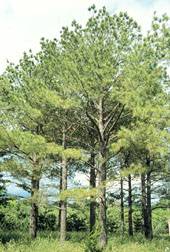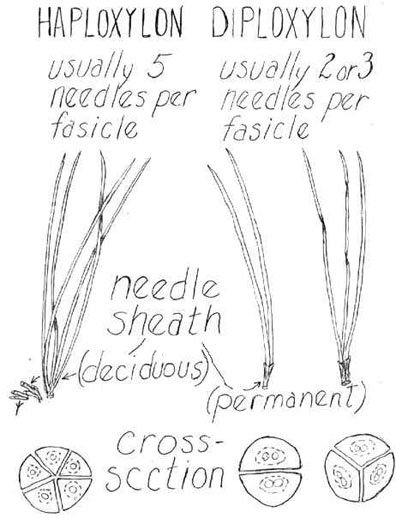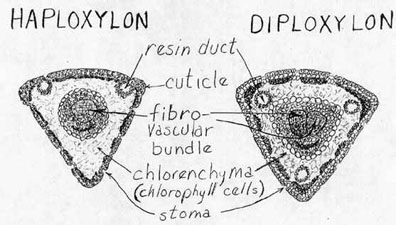
"Strange that so few come to the woods to see how
the pine lives and grows and
spires,
lifting its evergreen arms to the light -- to see its perfect success." -- Henry David Thoreau
What are Pine Trees ?

Pine trees (the genus Pinus) are distinguished from all other trees by: (a) having uncovered seeds borne in pairs on the bracts of (female) cones (as do other genera of the Pinaceae family) and (b) narrow leaves ("needles") arranged in bundles of 2 to 5 and with a permanent or deciduous sheath at their bases. Such bundles of needles are called fascicles (after the bundle of sticks around the axe which represented the power of the Roman senate). There are usually 2 to 5 leaves per fascicle (very rarely 1, or 6 to 8). The individual needles in one fascicle , when viewed in cross section, are like pie-shaped segments which fit together form a complete circle. Therefor each needle has a hemispherical cross section (if there are 2 needles per fascicle) or triangular cross section (if there are 3 or more needles per fascicle).
Pines are classically divided into two major
groups (subgenera):
Subgenus STROBUS :
Subgenus PINUS:

Pines are mostly large trees with a straight trunk with whorls of smaller lateral branches, but they have a wide range of habits varying from tall narrow trees to small bushy trees to prostrate shrubs. They are generally long-lived, usually over 100 years in suitable environments. The longest living individuals of any kind are the fabled intermountain bristlecone pine (Pinus longaeva) which currently has living trees at least 4,800 years old. (The root systems of the creosote bush (Larrea tridentata) may be even older). All pine species are evergreen, i.e., they keep their leaves for at least two growing seasons (and up to about 30 years in the case of P. longaeva)
They are monoecious, i.e., individual trees have both female (megasporangiate) cones which bear the ovules and male (microsporangiate) cones which shed the pollen. The pollen is carried by wind and gravity; none of the pines is pollinated by insects or birds. All pines have 12 pairs of chromosomes, as do other genera of the Pinaceae family except two (Douglas firs have 13 and false larches have 11).
About three-fifths of the pine species are currently classified in the subgenus Pinus (Diploxylon) pines, commonly called hard pines or yellow pines. The other two-fifths is comprised of the subgenus Strobus (Haploxylon) pines which are also called soft pines or white pines. (The new subgenus Ducampopinus would account for about one-fifth of the species, leaving approximately one-fifth in the genus Strobus). The subgenus Pinus has two fibrovascular bundles running the length of the needle (hence diploxylon) and the Strobus subgenus (and also Ducampopinus) has one (haploxylon) fibrovascular bundle. Diploxylon pines generally differ from the Haploxylon pines by having harder yellower wood, cones that are often armed with a prickle, stiffer needles with permanent needle sheaths and the development of rough scaly bark at a younger age.

The pine genus is generally sun-loving and relatively shade-intolerant. They are less likely than shade-tolerant genera (e.g. spruces and firs) to grow up from seedlings in an already established shady forest, so pine trees are less favored in mixed conifer and uneven-aged forests and often are not the "climax" trees in densely vegetated forests. But they are usually among the first trees to establish on open ground that is being revegetated after fire or other disturbance and are often found in pure even-age stands or in savanna (more open) settings where drought and fires control tree density. In the huge Longleaf pine forests along the Gulf and southeast Altlantic Coasts from east Texas to Virginia and Delaware, fire was just as essential as rain in preserving the pine's dominance.
The family Pinaceae evolved in the northern hemisphere during the early Cretaceous or Jurassic Period of the Mesozoic Era, 130 to 200 million years ago and by the late Cretaceous the genus Pinus had already differentiated into haploxylon and diploxylon subgenera. They have flourished and evolved into about 120 species and subspecies world-wide, still almost all in the northern hemisphere. Only one species (P. merkusii) extends about one degree south of the equator in Sumatra. They grow from desert edge to rain forests and from sea level to mountain treeline. The country with the most species of pines is Mexico, which has approximately 60 species and subspecies, followed by the United States (about 45) and China (about 21). The Mexican highlands have been an evolutionary center for new pine species.